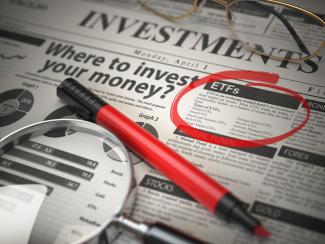
Understanding Exchange-Traded Funds
Thinking about where to invest your money can be overwhelming and confusing, especially for those who are unfamiliar with all options for investing. If you’d like to take advantage of the ease of stock trading with the diversification of mutual funds, exchange-traded funds (ETFs) can give you the best of both worlds. Here are some key things to know about ETFs before investing.
ETF Basics
Exchange-traded funds are baskets of securities—stocks, bonds, commodities or a combination of the three. The fund provider owns a group of assets and creates a fund to track the group’s performance. They then sell shares of that fund to investors. Some well-known ETFs include SPDR S&P 500 (SPY), which tracks the S&P 500 Index, and SPDR Gold Shares (GLD), which tracks physically-backed gold securities.
ETFs vs. Mutual Funds
One of the advantages of investing in an ETF is the diversification of funds without having to invest in each asset individually. In this respect, ETFs are similar to mutual funds, with a few key exceptions.
First, ETFs are traded on an exchange throughout the day, much like stocks. Mutual funds, on the other hand, are traded just once per day after the markets close. The price of an ETF could change throughout the day, but a mutual fund’s price will update daily.
There may also be a lower cost and more tax-efficiency advantages to investing in an ETF versus a mutual fund. For the most part, ETFs are tracked passively, which means management and operational costs are generally low. And compared to mutual funds, there is less turnover for ETFs. Less buying and selling of assets results in fewer capital gains and greater tax-efficiency. Additionally, investors in ETFs are only taxed upon selling their investment, whereas mutual fund investors incur a tax burden over the course of their investment.
Lastly, ETFs have greater transparency than mutual funds. Anyone can access the price activity for an ETF, and the fund’s holdings are disclosed each day to the public.
Potential Downfalls of ETFs
Although ETFs offer many benefits, there are some things to consider before investing. If you’re comparing the price of an ETF to investing in individual stocks, you may find that prices are higher because of broker commissions and management expenses.
In general, the risks of investing in an ETF is lower because it’s a diversified basket, but this could also mean that dividend yields are lower. More risk can come with more rewards, so if you’re looking for a higher payoff, you may want to invest in individual stocks instead of ETFs.
You should also be sure to research the type of ETF that you’re investing in. Actively-managed ETFs, while uncommon, will typically have higher fees associated with them. If you’re investing in a single industry-focused ETF, it could also hinder the amount of diversification that you’re looking for, especially compared to investments in individual stocks and other assets. As with any investment, it’s a good idea to talk to a financial professional before committing funds to make sure you are on the right track to meeting your financial goals.
*This content is developed from sources believed to be providing accurate information. The information provided is not written or intended as tax or legal advice and may not be relied on for purposes of avoiding any Federal tax penalties. Individuals are encouraged to seek advice from their own tax or legal counsel. Individuals involved in the estate planning process should work with an estate planning team, including their own personal legal or tax counsel. Neither the information presented nor any opinion expressed constitutes a representation by us of a specific investment or the purchase or sale of any securities. Asset allocation and diversification do not ensure a profit or protect against loss in declining markets. This material was developed and produced by Advisor Websites to provide information on a topic that may be of interest. Copyright 2021 Advisor Websites.
Exchange-traded funds are sold by prospectus. Please consider the investment objectives, risks, charges, and expenses carefully before investing. The prospectus, which contains this and other information about the investment company, can be obtained from the Fund Company or your financial professional. Be sure to read the prospectus carefully before deciding whether to invest.
ETFs are subject to secondary market trading risks. Shares of an ETF will be listed for trading on an exchange, however, there can be no guarantee that an active trading market for such shares will develop or continue. There can be no guarantee that an ETF's exchange listing or ability to trade its shares will continue or remain unchanged. Shares of an ETF may trade on an exchange at prices at, above or below their most recent NAV. The per share NAV of an ETF is calculated at the end of each business day, and fluctuates with changes in the market value of the Fund’s holdings. The trading prices of an ETF's shares fluctuate continuously throughout the trading day based on market supply and demand, which may not correlate to NAV.
The trading prices of an ETF's shares may differ significantly from NAV during periods of market volatility, which may, among other factors, lead to the Fund’s shares trading at a premium or discount to NAV. Exchange Traded Funds (“ETF”) are afforded certain exemptions from the Investment Company Act. The exemptions allow, among other things, for individual shares to trade on the secondary market. Individual shares cannot be directly purchased from or redeemed by the ETF. Purchases and redemptions directly with ETFs are only accomplished through creation unit aggregations or “baskets” of shares. Shares of an ETF, traded on the secondary market, are bought and sold at market price (not NAV). Brokerage commissions will reduce returns. Investment policies, management fees and other information can be found in the individual ETF’s prospectus.


